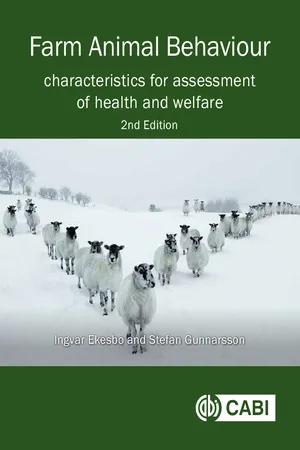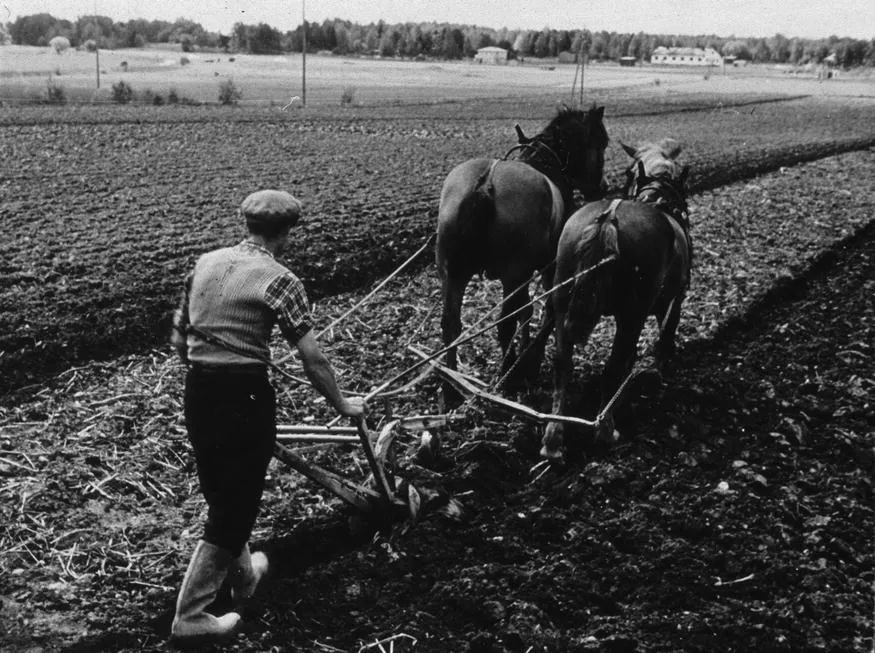![]() PART I Domesticated Mammals
PART I Domesticated Mammals ![]()
1 Horse (Equus caballus)
1.1 Domestication, Changes in the Animals, their Environment and Management
At the end of the Ice Age, wild horses existed in Europe and north Asia, from Spain in the west to the Bering Strait in the east. The southern boundary was the huge Asiatic mountain chains. Wild horses did not exist in America, Africa, south Asia or Australia. They were originally inhabitants of temperate, well-watered grasslands.
The horse was the last of the five most common livestock animals to be domesticated, which may have happened about 2500 bc (Mason, 1984). However, Anthony (1986) and Budiansky (1997) claimed that horses might have been kept in the Ukraine in 4000 bc, first for meat and later for riding. Three independent lines of evidence demonstrate domestication in the Eneolithic Botai Culture of Kazakhstan, dating to about 3500 bc. Pathological characteristics indicate that some Botai horses were bridled and perhaps ridden, and archaeological remains of processed milk indicate that mares were milked (Outram et al., 2009). They were brought south of the Caucasus by mounted Aryans, and were soon in widespread use for light chariots as far afield as Greece and Egypt (1570 bc), India and China (1300 bc). At this date, most horses were small, and few were ridden (Drower, 1969). However, it cannot have been long before the early farmers found that horses could be loaded and ridden, and even pull carts (Clutton-Brock, 1999). The ancestors were wild horses, Equus ferus, and among them the tarpan, E. ferus gmelini (Zeuner, 1963; Clutton-Brock, 1999). Although some authors (Kowalski, 1967) claim that the Przewalski horse, E. ferus Przewalski, is linked directly to the ancestors of the domestic European horses, this seems unlikely (Clutton-Brock, 1999). There are thus only slight differences between scientists regarding the origin of horses. Domestic horses arose from wild stock distributed over a moderately extensive geographical region, large enough to have contained considerable pre-existing haplotype diversity (Lister et al., 1998; Lister, 2001). Several distinct horse populations were involved in the domestication of the horse (Vilà et al., 2001; Jansen et al., 2002). Apparently, domestic horses derive from several wild horse genepools over a large geographic area, and possibly over a long period.
The mitochondrial genomes of modern horse breeds shared a common ancestor around 93,000 years ago, and no later than 38,000 years ago. There seems to be a significant population expansion beginning 6000–8000 years ago, with an ongoing exponential growth until the present, similar to other domestic animal species. A large sample of wild horse diversity was incorporated into the domestic population before the beginning of domestication about 5000 years ago (Lippold et al., 2011; Warmuth et al., 2012).
At the Paleolithic site of Schöningen, Germany, numerous bones of butchered horses were deposited c.300,000 years ago, and were later discovered in organic sediments at a former lake shore. The large horse Equus mosbachensis dominates (Conard et al., 2015; Schoch et al., 2015; Van Kolfschoten et al., 2015). More than 200 archaeological sites from the beginning of the Holocene (9600 years ago) to the end of the Atlantic Period (3750 years ago) have been found in Europe with records of wild horses. Domestic horses represent a genetic paradox: although they have the greatest number of maternal lineages of all domestic species, their paternal lineages are extremely homogeneous on the Y-chromosome (Cieslak et al., 2010; Sommer et al., 2011; Kysely and Peske, 2016; Martin et al., 2016).
The first domesticated horses might have been the size of large ponies, with upstanding manes. According to archaeological findings, the first horses in the north were smaller and sturdier than those in the south, which were larger and more slender limbed. Most domestic horses in the ancient world were less than 145 cm in withers height, in Eastern Europe about 135 cm and in Western Europe 125–130 cm. The great majority were less than 125 cm. At the onset of domestication, early domestic horses showed less change in size and general morphology from their wild counterparts than did other species of livestock, e.g. cattle (Clutton-Brock, 1999).
All horse colour phenotypes that seem to be distinguishable in cave paintings have now been found to exist in prehistoric horse populations, suggesting that cave paintings of this species represent remarkably realistic depictions of the animals shown (Pruvost et al., 2011).
The horse represents the domestic animal that has most impacted human history, providing us with rapid transportation, which has changed considerably the speed and magnitude of the circulation of goods and people, as well as their cultures and diseases (Librado et al., 2016).
During the mutual history of horse and humans, the horse has had a very high-ranking status, being an aristocrat of livestock, irrespective of culture, age and people. In the first place, humans exploited the horse’s speed and strength for riding and draught. In addition, some nomadic people in Central Asia used mare’s milk for consumption. The consumption of horse meat was common in the early domestication period, but diminished during the Roman age and was discontinued during the transition to the Christian age. However, it still occurs; for example, in Iceland and Hungary. Horse meat is eaten as ‘salt meat’ in many countries.
The horse was, over thousands of years and until the 1950s, important to humans as a draught animal in agriculture and forestry (Figs 1.1 and 1.2). Several breeds could accomplish an impressive traction force. A very strong bond often developed between a single horse and his owner. Since World War II, horses have played an increasing role in sports and recreation for a great number of people. Riding and looking after a horse has taught many children and young people to respect animal behaviour and to take responsibility for an animal (Fig. 1.3).
The housing and management of the horse has not undergone a dramatic change, as is the case with cattle, swine and poultry. The way horses are kept in different countries is based mainly on traditional practice. Horses are kept socially isolated from conspecifics, maybe more than any other domestic animal, and humans therefore are an important part of the horse’s social environment. The behaviour, manner and treatment of a horse by humans influence its social life to a very great extent. Unsuitable housing or keeping a horse isolated indoors day after day is thus detrimental and will often result in abnormal behaviour.
The skeleton of a horse’s extremities indicates its specialization in running fast. In the horse, three of the original four toes (Budiansky, 1997) are regressive. The hoof represents the third toe. The forelegs and hind legs are equipped with tendon arrangements that make it possible for the horse to rest, and even sleep, standing. In the large intestine, and especially in the caecum, cellulose fermentation takes place.
In the upper and lower jaw, there are, on both sides, three front and six back teeth: 36 teeth in total. The permanent set of teeth is complete at 5 years of age (Sisson and Grossman, 1948). Between the front and back teeth there is a gap, the diastema, where the bit of the bridle is applied when the horse is bridled. It is possible to judge the age of a horse by means of the teeth’s appearance and the bite.
The horse is one of the most differentiated of all domesticated animals. The horses of the 2000s vary in size from 71 to 76 cm in withers height of the smallest breed, Falabella, to about 190 cm in height of the largest breed, Shire. There are more than 680 breeds in the world, and the number of horses was estimated at 62 million in the early 2000s (Hall, 2005). There is no evidence that any single behaviour necessary for survival has disappeared during the domestication process. Thus, when domesticated horses are kept in confined areas, e.g. paddocks, they try to use the grounds in the same way as wild horses – to use certain surfaces for defecation and urinating, others for grazing and yet others for rolling on the ground or other similar body care (Fraser, 1992).
At 3–5 years of age, the horse is full-grown, and it can usually live to be 20–30 years old.
The male horse is described as a ‘stallion’, the female as a ‘mare’ and the offspring as a ‘foal’. The expression ‘colt’ is used generally for a foal that is more than about 6 months old. ‘Colt’ is sometimes used for young males and ‘filly’ for young females.
1.2 Innate or Learned Behaviour
In horses, as in other animals, certain behaviours are innate, others learned. Innate behaviours are, for example: the suckling of a foal; a foal following its mother; getting up and lying down behaviour; body positions at resting, standing or lying, at urination and defecation, or during intense rain and wind. Some innate behaviour, body positions, for example, will usually be performed irrespective of external conditions.
There are innate behavioural differences between breeds, for example for anxiousness and excitability (Lloyd et al., 2008).
Studies indicate that horses can learn to eat or avoid different sorts of feed (Pfister et al., 2002). Examples of learned behaviour are, for example, manipulating devices in order to get feed (Winskill et al., 1996). However, the most conspicuous example of learning in horses is the different behaviours taught by humans; from lifting the hoof to obeying a rider’s, coach...



